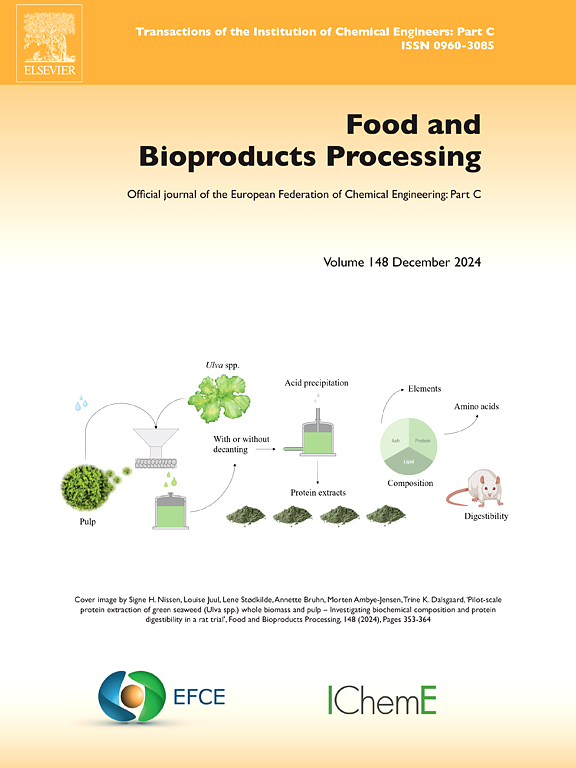Synergistic effect of a VCO-ethanol solvent mixture and ultrasound-assisted extraction in enhancing xanthone extraction from mangosteen pericarp
IF 3.5
2区 农林科学
Q2 BIOTECHNOLOGY & APPLIED MICROBIOLOGY
引用次数: 0
Abstract
Xanthone, a bioactive compound from mangosteen pericarp (MP), is increasingly valued for its applications in functional foods, cosmetics, and pharmaceuticals due to its diverse medicinal properties. However, optimizing extraction methods, particularly solvent selection and technique, remains a challenge. This study introduces an innovative binary solvent mixture of virgin coconut oil (VCO) and ethanol, combined with ultrasound-assisted extraction (UAE), to significantly enhance xanthone yield. Solubility studies of xanthone in ethanol-VCO mixtures were conducted at four temperatures (303.15–323.15 K) across eleven volume ratios (0:1–1:0). The results demonstrated that the mixed-solvent achieved superior xanthone solubility compared to pure ethanol or VCO, with the maximum solubility (0.0329 g/g) observed at a VCO mass fraction of 0.63 at 323.15 K. The Jouyban-Acree model was modified and successfully correlated the solubility data, achieving an R2 value of 0.999. Applying this optimized solvent mixture in UAE, xanthone concentration increased by up to 12 % compared to VCO alone with α-mangostin reaching 83.167 mg/g MP, with a linear relationship observed between ultrasound intensity, extraction time, and xanthone yield. The kinetics of UAE were effectively modeled using Peleg’s model, the pseudo-second-order kinetic model type 2, and the Response Surface Method. This mixed solvent method offers a more efficient and sustainable alternative to single-solvent, representing a significant advancement in xanthone extraction technology. The plant oil-based binary solvent developed in this study introduces a novel option for researchers working on the extraction of green plant compounds. Furthermore, it holds promising applications across various chemical engineering industries.
vco -乙醇混合溶剂与超声辅助萃取对山竹果皮中山酮提取的协同作用
山酮是山竹果皮(MP)的一种生物活性化合物,由于其多种药用特性,在功能食品、化妆品和药品等方面的应用越来越受到重视。然而,优化提取方法,特别是溶剂的选择和技术,仍然是一个挑战。本研究介绍了一种新型的由初榨椰子油(VCO)和乙醇组成的二元溶剂混合物,结合超声辅助提取(UAE),可以显著提高山酮的收率。在4种温度(303.15-323.15 K)、11种体积比(0:1-1:0)下,研究了山酮在乙醇- vco混合物中的溶解度。结果表明,与纯乙醇或VCO相比,混合溶剂具有更好的山酮溶解度,在323.15 K下,当VCO质量分数为0.63时,最大溶解度为0.0329 g/g。对Jouyban-Acree模型进行了改进,并成功地将溶解度数据进行了关联,R2值为0.999。与VCO单独提取相比,α-山竹苷浓度提高了12 %,α-山竹苷达到83.167 mg/g MP,超声强度、提取时间与山酮得率呈线性关系。采用Peleg模型、伪二阶动力学模型2和响应面法对UAE的动力学进行了有效的建模。这种混合溶剂法是一种比单一溶剂法更有效、更可持续的提取方法,代表了山酮提取技术的重大进步。本研究开发的植物油基二元溶剂为绿色植物化合物的提取研究人员提供了一种新的选择。此外,它在各种化学工程行业中具有很好的应用前景。
本文章由计算机程序翻译,如有差异,请以英文原文为准。
求助全文
约1分钟内获得全文
求助全文
来源期刊

Food and Bioproducts Processing
工程技术-工程:化工
CiteScore
9.70
自引率
4.30%
发文量
115
审稿时长
24 days
期刊介绍:
Official Journal of the European Federation of Chemical Engineering:
Part C
FBP aims to be the principal international journal for publication of high quality, original papers in the branches of engineering and science dedicated to the safe processing of biological products. It is the only journal to exploit the synergy between biotechnology, bioprocessing and food engineering.
Papers showing how research results can be used in engineering design, and accounts of experimental or theoretical research work bringing new perspectives to established principles, highlighting unsolved problems or indicating directions for future research, are particularly welcome. Contributions that deal with new developments in equipment or processes and that can be given quantitative expression are encouraged. The journal is especially interested in papers that extend the boundaries of food and bioproducts processing.
The journal has a strong emphasis on the interface between engineering and food or bioproducts. Papers that are not likely to be published are those:
• Primarily concerned with food formulation
• That use experimental design techniques to obtain response surfaces but gain little insight from them
• That are empirical and ignore established mechanistic models, e.g., empirical drying curves
• That are primarily concerned about sensory evaluation and colour
• Concern the extraction, encapsulation and/or antioxidant activity of a specific biological material without providing insight that could be applied to a similar but different material,
• Containing only chemical analyses of biological materials.
 求助内容:
求助内容: 应助结果提醒方式:
应助结果提醒方式:


